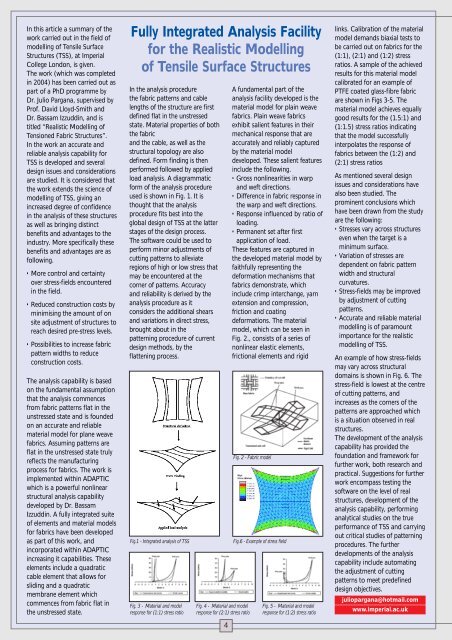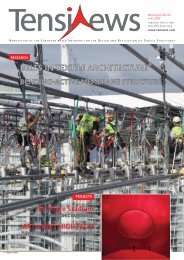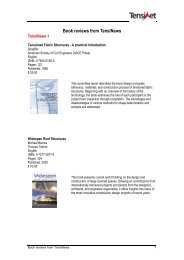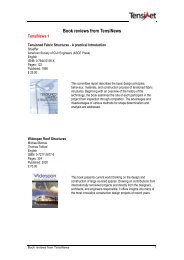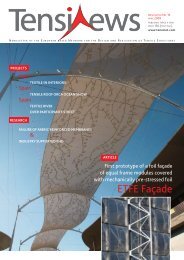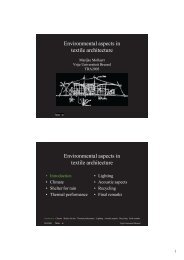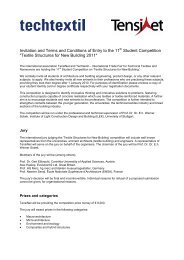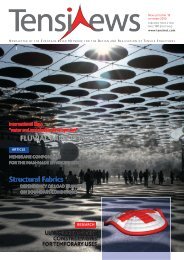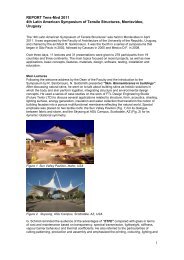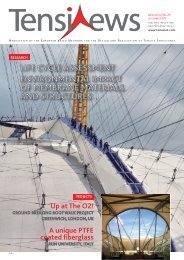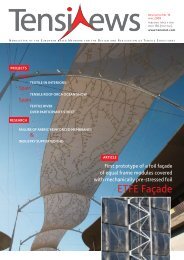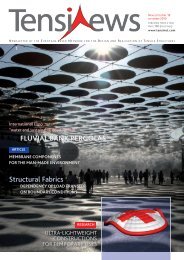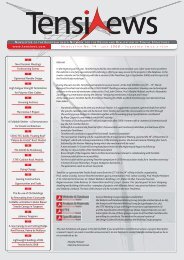TensiNews 9 - TensiNet
TensiNews 9 - TensiNet
TensiNews 9 - TensiNet
You also want an ePaper? Increase the reach of your titles
YUMPU automatically turns print PDFs into web optimized ePapers that Google loves.
In this article a summary of thework carried out in the field ofmodelling of Tensile SurfaceStructures (TSS), at ImperialCollege London, is given.The work (which was completedin 2004) has been carried out aspart of a PhD programme byDr. Julio Pargana, supervised byProf. David Lloyd-Smith andDr. Bassam Izzuddin, and istitled “Realistic Modelling ofTensioned Fabric Structures”.In the work an accurate andreliable analysis capability forTSS is developed and severaldesign issues and considerationsare studied. It is considered thatthe work extends the science ofmodelling of TSS, giving anincreased degree of confidencein the analysis of these structuresas well as bringing distinctbenefits and advantages to theindustry. More specifically thesebenefits and advantages are asfollowing.• More control and certaintyover stress-fields encounteredin the field.• Reduced construction costs byminimising the amount of onsite adjustment of structures toreach desired pre-stress levels.• Possibilities to increase fabricpattern widths to reduceconstruction costs.The analysis capability is basedon the fundamental assumptionthat the analysis commencesfrom fabric patterns flat in theunstressed state and is foundedon an accurate and reliablematerial model for plane weavefabrics. Assuming patterns areflat in the unstressed state trulyreflects the manufacturingprocess for fabrics. The work isimplemented within ADAPTICwhich is a powerful nonlinearstructural analysis capabilitydeveloped by Dr. BassamIzzuddin. A fully integrated suiteof elements and material modelsfor fabrics have been developedas part of this work, andincorporated within ADAPTICincreasing it capabilities. Theseelements include a quadraticcable element that allows forsliding and a quadraticmembrane element whichcommences from fabric flat inthe unstressed state.Fully Integrated Analysis Facilityfor the Realistic Modellingof Tensile Surface StructuresIn the analysis procedurethe fabric patterns and cablelengths of the structure are firstdefined flat in the unstressedstate. Material properties of boththe fabricand the cable, as well as thestructural topology are alsodefined. Form finding is thenperformed followed by appliedload analysis. A diagrammaticform of the analysis procedureused is shown in Fig. 1. It isthought that the analysisprocedure fits best into theglobal design of TSS at the latterstages of the design process.The software could be used toperform minor adjustments ofcutting patterns to alleviateregions of high or low stress thatmay be encountered at thecorner of patterns. Accuracyand reliability is derived by theanalysis procedure as itconsiders the additional shearsand variations in direct stress,brought about in thepatterning procedure of currentdesign methods, by theflattening process.Fig.1 - Integrated analysis of TSSFig. 3 - Material and modelresponse for (1:1) stress ratioFig. 4 - Material and modelresponse for (2:1) stress ratio4A fundamental part of theanalysis facility developed is thematerial model for plain weavefabrics. Plain weave fabricsexhibit salient features in theirmechanical response that areaccurately and reliably capturedby the material modeldeveloped. These salient featuresinclude the following.• Gross nonlinearities in warpand weft directions.• Difference in fabric response inthe warp and weft directions.• Response influenced by ratio ofloading.• Permanent set after firstapplication of load.These features are captured inthe developed material model byfaithfully representing thedeformation mechanisms thatfabrics demonstrate, whichinclude crimp interchange, yarnextension and compression,friction and coatingdeformations. The materialmodel, which can be seen inFig. 2., consists of a series ofnonlinear elastic elements,frictional elements and rigidFig. 2 - Fabric modelFig.6 - Example of stress fieldFig. 5 - Material and modelresponse for (1:2) stress ratiolinks. Calibration of the materialmodel demands biaxial tests tobe carried out on fabrics for the(1:1), (2:1) and (1:2) stressratios. A sample of the achievedresults for this material modelcalibrated for an example ofPTFE coated glass-fibre fabricare shown in Figs 3-5. Thematerial model achieves equallygood results for the (1.5:1) and(1:1.5) stress ratios indicatingthat the model successfullyinterpolates the response offabrics between the (1:2) and(2:1) stress ratiosAs mentioned several designissues and considerations havealso been studied. Theprominent conclusions whichhave been drawn from the studyare the following:• Stresses vary across structureseven when the target is aminimum surface.• Variation of stresses aredependent on fabric patternwidth and structuralcurvatures.• Stress-fields may be improvedby adjustment of cuttingpatterns.• Accurate and reliable materialmodelling is of paramountimportance for the realisticmodelling of TSS.An example of how stress-fieldsmay vary across structuraldomains is shown in Fig. 6. Thestress-field is lowest at the centreof cutting patterns, andincreases as the corners of thepatterns are approached whichis a situation observed in realstructures.The development of the analysiscapability has provided thefoundation and framework forfurther work, both research andpractical. Suggestions for furtherwork encompass testing thesoftware on the level of realstructures, development of theanalysis capability, performinganalytical studies on the trueperformance of TSS and carryingout critical studies of patterningprocedures. The furtherdevelopments of the analysiscapability include automatingthe adjustment of cuttingpatterns to meet predefineddesign objectives.juliopargana@hotmail.comwww.imperial.ac.uk


